Related Research Articles

An out-of-place artifact is an artifact of historical, archaeological, or paleontological interest to someone that is claimed to have been found in an unusual context, which someone claims to challenge conventional historical chronology by its presence in that context. Some people might think that those artifacts are too advanced for the technology known to have existed at the time, or that human presence existed at a time before humans are known to have existed. Other people might hypothesize about a contact between different cultures that is hard to account for with conventional historical understanding.

The Plain of Jars is a megalithic archaeological landscape in Laos. It consists of thousands of stone jars scattered around the upland valleys and the lower foothills of the central plain of the Xiangkhoang Plateau. The jars are arranged in clusters ranging in number from one to several hundred.

Mamallapuram, is a town in Chengalpattu district in the southeastern Indian state of Tamil Nadu, best known for the UNESCO World Heritage Site of 7th- and 8th-century Hindu Group of Monuments at Mahabalipuram. It is one of the famous tourist sites in India. The ancient name of the place is Thirukadalmallai. It is a part of Chennai Metropolitan Area. It is a satellite town of Chennai.
Sadiya is a town in Tinsukia district, Assam. It was the capital of the Chutia Kingdom and after the downfall of the kingdom it became the seat of the Sadiya-khowa-Gohain of the Ahom kingdom. Extensive remains of buildings and fortifications built during the rule of the Chutias near Sadiya still point to the importance of the region in the past. Historically Sadiya referred to the Chutiya kingdom which included at times the districts of Lakhimpur, Dhemaji and Tinsukia. It is claimed to be the center of development of the eastern Assamese dialects, the inscription here are written in a Tai script. Its stands on a grassy plain, almost surrounded by forested Himalayan mountains, on the right bank of Lohit River which is locally considered the main stream of the Brahmaputra River. The deepest point of the Brahmaputra River is located near this village. It is famous for a flower named satphul, which is much like Jasmine.
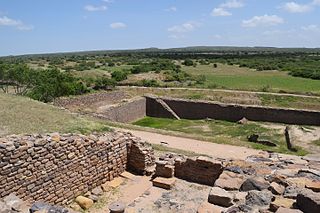
Dholavira is an archaeological site at Khadirbet in Bhachau Taluka of Kutch District, in the state of Gujarat in western India, which has taken its name from a modern-day village 1 kilometre (0.62 mi) south of it. This village is 165 km (103 mi) from Radhanpur. Also known locally as Kotada timba, the site contains ruins of a city of the ancient Indus Valley civilization. Earthquakes have repeatedly affected Dholavira, including a particularly severe one around 2600 BCE.

The Tabon Caves is a cave system located in Lipuun Point, Panitian, Quezon, Palawan in the Philippines. Dubbed as the country's "cradle of civilization", it is a site of archaeological importance due to the number of jar burials and prehistoric human remains found starting from the 1960s, most notably the Tabon Man. The system is a part of the Lipuun Point Reservation, which has been protected by the Philippine government as a museum reservation to protect the caves and its immediate vicinity from deforestation and to preserve the cultural artifacts present there.

Tamil-Brahmi, also known as Tamili or Damili, was a variant of the Brahmi script in southern India. It was used to write inscriptions in the early form of Old Tamil. The Tamil-Brahmi script has been paleographically and stratigraphically dated between the third century BCE and the first century CE, and it constitutes the earliest known writing system evidenced in many parts of Tamil Nadu, Kerala, Andhra Pradesh and Sri Lanka. Tamil Brahmi inscriptions have been found on cave entrances, stone beds, potsherds, jar burials, coins, seals, and rings.
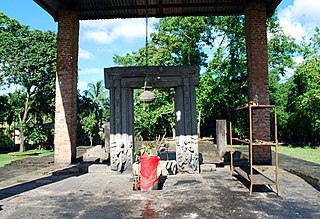
Da Parbatia is a small village very close to west Tezpur, in the Indian State of Assam. In the village there are significant architectural remnants of an ancient temple of the 6th century overlying the ruins of another Shiva temple built of bricks during the Ahom period. Archaeological excavations done here in 1924 have unearthed a sixth-century antiquity in the form of a stone door frame with extensive carvings. The ruins of the temple built during the Ahom period are built over the ancient temple's foundations and are in the form of a stone paved layout plan of the sanctum sanctorum and a mandapa. This complex is under the jurisdiction of the Archaeological Survey of India and its importance and notability is recorded under the Ancient Monuments and Archaeological Sites and Remains Act 1958.
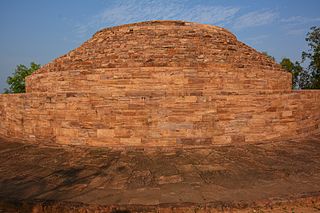
Lalitagiri is a major Buddhist complex in the Indian state of Odisha. The complex is home to stupas, 'esoteric' Buddha images, and monasteries (viharas), which is the oldest site in the region. Significant finds at this complex include Buddha's relics. Tantric Buddhism was practiced at this site.
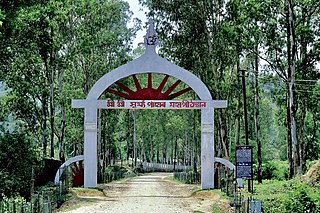
Sri Surya Pahar is located about 12 km southeast of Goalpara, about 132 km northwest of Guwahati, is a significant but relatively unknown archaeological site in Assam, India. Goalpara is the nearest city from the site. The site is a hilly terrain where several rock-cut Shivalingas, votive stupas and the deities of Hindu, Buddhist and Jain pantheon are scattered in an area of about one km. The site is centered on the hills (Pahar) of Sri Surya which is profusely filled up with Shiva Lingas (Lingam). People have found 99999 Shiva Lingas were engraved here by Vyasa in order to build up a second Kashi and once it was one of the holiest pilgrimage sites in the region. There is no historical evidence exactly how many Lingams once dotted in these hills, but still there are hundreds of them, from tiny to large in size, scattered everywhere at the foot of the hill and covering the extensive area after centuries of neglect and pilferage. The exact figure of the Lingas in the hill is yet to be counted scientifically.
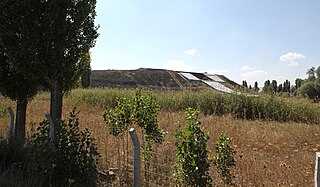
Kaman-Kalehöyük is a multi-period archaeological site in Kırşehir Province, Turkey, around 100 km south east of Ankara, 6 km east of the town center of Kaman. It is a tell or mound site that was occupied during the Bronze Age, Iron Age and Ottoman periods. Excavations in the mound have been carried out since 1986 under the direction of Sachihiro Omura, on behalf of the Middle Eastern Culture Center in Japan and the Japanese Anatolian Archeology Institute. The distance to Hattusa, the Hittite capital, is about 100 km.
The year 2012 in archaeology involved some significant events.

The stone circles of Junapani are prehistoric megalithic circles in Junapani, near Nagpur in the Indian state of Maharashtra. There are about 300 such stone circles noted around Junapani. They were first excavated by J. H. Rivett-Carnac in 1879, yielding a variety of iron objects including daggers, flat axes with cross-ring fasteners, hoes, rings, bracelets, horse bits, chisels with long blades, and pointed tongs, possibly covered with a wooden handle. There is also evidence of black and red pottery, such as bowls featuring linear paintings in black. The burial sites were characterized by cairns. About 150 stone circles have been studied and documented. A notable feature is the cup-marked stones in the circles which seem to suggest an astronomical significance. This aspect has been discerned from the fact that the cup-marked stones are fixed at specific locations denoting specific directions.

The Burzahom archaeological site is located in the Srinagar district of the Kashmir Valley of Jammu and Kashmir, India. Archaeological excavations have revealed four phases of cultural significance between 3000 BCE and 1000 BCE. Periods I and II represent the Neolithic era; Period III the Megalithic era ; and Period IV relates to the early Historical Period. The findings, recorded in stratified cultural deposits representing prehistoric human activity in Kashmir, are based on detailed investigations that cover all aspects of the physical evidence of the site, including the ancient flora and fauna.

The archaeology of the Philippines is the study of past societies in the territory of the modern Republic of the Philippines, an island country in Southeast Asia, through material culture.
This page lists major events of 2019 in archaeology.
This page lists major events of 2020 in archaeology.
This page lists major events of 2021 in archaeology.
This page lists significant events of 2023 in archaeology.

A stone vessel is a hollow container, made of stone.
References
- ↑ "Mysterious giant stone jars found in India | Australian National University". anu.edu.au. Retrieved 2024-04-27.
- ↑ "We don't know who made the giant stone jars found in northern India". Ars Technica. Retrieved 2024-04-27.
- ↑ Megan Marples. "Giant, mysterious megalithic jars were unearthed in northeastern India". CNN. Retrieved 2024-04-27.
- ↑ "Assam: 'Mysterious' giant stone jars found in India". BBC News. Retrieved 2024-04-27.